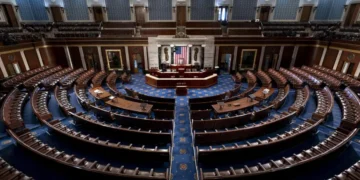November 17, 2025 Story by: Publisher
The U.S. Department of Justice filed a lawsuit aiming to stop California from implementing its newly drawn congressional district boundaries, accusing state leaders of adopting a redistricting plan that unlawfully relies on race and could shift the balance of power in the U.S. House of Representatives.
According to the Justice Department’s complaint, the state’s new map—signed by Governor Gavin Newsom and approved under a redistricting process—violates the Constitution and the Voting Rights Act by sorting voters primarily on the basis of race. Federal officials argue the plan was engineered to consolidate Latino voters in several districts, a move they say constitutes impermissible racial gerrymandering.
The lawsuit states that California “has drawn district lines where race was the predominant factor without sufficient justification,” setting up a major constitutional battle over how far states may go when considering race as part of redistricting.
The legal action filed against Governor Gavin Newsom and Secretary of State Shirley Weber for the State of California’s newly adopted redistricting plan enacted with the passage of Proposition 50. The suit alleges that the plan mandates racially gerrymandered congressional districts in violation of the Equal Protection Clause of the Fourteenth Amendment to the U.S. Constitution.
Under Proposition 50, California will adopt a new set of congressional district boundaries drawn by the Legislature, rather than by the California Citizens Redistricting Commission, the independent commission established to draw fair maps after the decennial census. The measure reinstates legislative mapmaking for three cycles, after which control returns to the Commission.
California approved a package of bills in late August that established a November special election, where voters decided on a new congressional map. Governor Gavin Newsom signed the bills into law, officially allowing Californians to determine whether lawmakers can redraw the state’s congressional districts.”
The move comes in direct response to a mid-decade redistricting initiative in Texas that is poised to add five GOP-leaning districts
Prop 50: A temporary suspension of independent redistricting
California’s measure—known as Proposition 50 (Election Rigging Response Act)—would temporarily bypass the state’s independent Citizens Redistricting Commission. If approved, the new Democratic-favoring district lines would apply for elections in 2026, 2028, and 2030, reverting to nonpartisan map drawing after the 2030 census.
The chamber passed the constitutional amendment authorizing the maps by a 57-20 vote. The chamber passed the maps themselves and a bill funding the redistricting by similar margins, while the Senate passed each of the three measures with a 30–8 vote—all along party lines.
About the legislative package
- Assembly Constitutional Amendment 8 (Rivas, McGuire): allows Californians the ability to adopt a new, temporary Congressional map that neutralizes Trump’s power grab only if Texas, Florida, Indiana, or any other Republican-led state redraw their maps.
- Senate Bill 280 (Cervantes, Pellerin): establishes timelines and procedures to conduct a statewide special election for Proposition 50, and provides the funding for the special election, set to take place on November 4, 2025.
- Assembly Bill 604 (Aguiar-Curry, Gonzalez): establishes the temporary Congressional District Maps that would take effect if other states engage in mid-cycle partisan gerrymanders.
This bill package builds on Governor Newsom’s framework announced last week in Los Angeles at the Democracy Center, alongside leaders from across the Golden State like Planned Parenthood, labor unions, community organizations and educators, as well as key elected officials at the federal, state, and local level.
Texas mid-decade redistricting
Texas State House of Representatives voted Wednesday, August 20, to give initial approval to redrawn congressional map that may create five new GOP seats in Congress. The new map aims to flip five Democratic-held U.S. House seats in the 2026 midterm elections. The vote followed a two-week walkout by dozens of Democratic lawmakers, which had temporarily delayed the bill’s passage.
The Texas Senate approved new redistricting maps on Tuesday, August 12, despite a walkout by some Democratic lawmakers.
Democratic lawmakers left the state on Sunday, August 3, in an effort to prevent a vote on the proposed congressional maps.
The maneuver, undertaken by most of the Texas House’s 62 Democrats, deprives the Republican-controlled chamber of a quorum — the number of lawmakers needed to function under House rules — ahead of a scheduled vote on the draft map. The 150-member House can only conduct business if at least 100 members are present, meaning the absence of 51 or more Democrats can bring the Legislature’s ongoing special session to a halt.
A Texas House redistricting panel approved a new congressional map on August 1. The map advanced on a strict party-line 12–6 vote, moving closer to a full chamber vote. The plan targets urban Democratic strongholds including Austin, Houston, and Dallas, reshaping district lines in South Texas and beyond to favor Republican performance.
In 2024, Trump won 56.2% of votes in Texas. Under the current lines, Republicans hold 66% of Texas’ 38 House seats. The new map aims to push that share to 79%.
Texas state Republicans on Wednesday, July 30 unveiled a new congressional map that would give the GOP a clear path to flip five U.S. House seats currently held by Democrats—solidifying their grip on power ahead of the pivotal 2026 midterms.
The proposed map was filed by state Rep. Todd Hunter, who represents a coastal area in southeastern Texas and is a member of the state House Select Committee on Congressional Redistricting created last week as part of the special legislative session called by Republican Texas Gov. Greg Abbott.
Source: Justice Department / PBS

















